A dark car speeding through the night bursts suddenly into a thousand pieces, forming brilliant metallic creatures on the surface of an alien planet. Such is the action in ShapeShifter, a short film entirely conceived and created by New York studio Charlex. We take a look at how the film, directed by Charlex founder Alex Weil and narrated by Gabriel Byrne, came to be.
Drawing upon Charlex’s 2006 film One Rat Short to create another design opportunity for the studio’s artists, Weil sought to bring a dreamlike quality to ShapeShifter. The animation is combined with a Fitzgerald Scott poem read by Byrne, suitably entitled ‘Dreams’, and a musical track by Stimmung’s Peter Lauridsen. “Our original intent was simply to have an unfettered creative outlet for the many talented people that are part of our company,” says Weil.
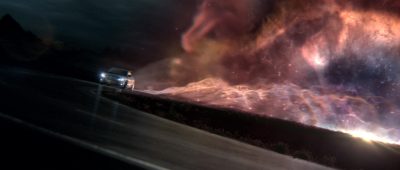
Co-director and designer Diana Park was the original designer of the piece that became ShapeShifter. “I wanted to try something different,” says Park. “My inspiration was crafting the image of a machine creating nature. Usually it’s the other way around, but conceptually and aesthetically, I thought it would be fun and challenging to mix the two.”
Artists used Park’s storyboards as a starting point, creating much of the composition and staging in previs. “We would thumbnail out different compositions,” says Weil, “and then immediately go onto the computer and try them out in motion. The characters were moving so quickly and the environments in the story change so fast it was the only real way to tell if the shot was working and flowing in the edit.”
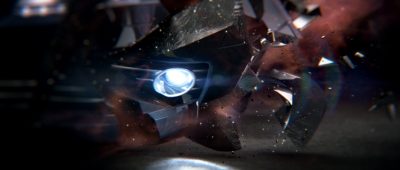 From a technical point of view, Weil says the biggest challenge on the short was animating the shatter sequences. “The objects that were breaking up were not static like a statue or building,” he says. “They were deforming shapes that shattered over time while the character ran or jumped in slow motion. We had to fracture the animals by hand to get the right shapes we wanted.”
From a technical point of view, Weil says the biggest challenge on the short was animating the shatter sequences. “The objects that were breaking up were not static like a statue or building,” he says. “They were deforming shapes that shattered over time while the character ran or jumped in slow motion. We had to fracture the animals by hand to get the right shapes we wanted.”
To create the shatter pieces, modelers copied actual chunks of obsidian that were broken off of a larger piece. “We actually purchased a piece of obsidian online!” says Weil. “We then used these modeled pieces to carve out chunks of our characters. This was done one piece at a time until the whole character was cut into the right sized chunks. Each character would result in about a thousand pieces. It involved much trial and error.”
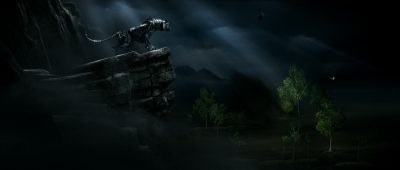 For the animals that turn into shards, Charlex created special shatter rigs with hundreds of pieces for each character in addition to the regular rig. “The shatter rigs were tricky as the shatter pieces had to go from rigid pieces of obsidian to forming an organic flexible character mid-action,” notes Weil. “This transition had to happen seamlessly. We ended up using a combination of blend-shapes and animated constraints.”
For the animals that turn into shards, Charlex created special shatter rigs with hundreds of pieces for each character in addition to the regular rig. “The shatter rigs were tricky as the shatter pieces had to go from rigid pieces of obsidian to forming an organic flexible character mid-action,” notes Weil. “This transition had to happen seamlessly. We ended up using a combination of blend-shapes and animated constraints.”
The short has a heavy focus on nature, including trees, earth and water, that required specific CG approaches. “We wanted a lot of growth happening in all the shots,” says Weil, “so we ended up using a lot of Maya’s procedural PaintFX system for creating plants and organic branching structures. Everything from the leaves and twigs to the wild flowers and sea anemone were handled and animated using PaintFX. For more close-up flowers and other elements we used hand-modeled flowers with detailed rigging to get the motion and offset we were looking for in those ‘hero’ moments.”
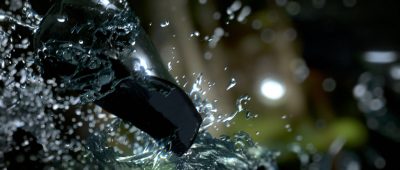 To depict water, Charlex relied on a mix of techniques. Slow motion close-ups were generated as RealFlow simulations, for example. “The scene where the pieces fall underwater was a challenge with all the splashes, surface tensions and bubbles,” explains Weil. “FX artist Mitch Deoudes came up with a great technique to mimic the large bubble that forms when an object hits the water at high speed. He used cloth simulations to create this ‘water sock’ and he integrated all the effects together really nicely.” Other water effects included live-action splash or drip elements that were composited into the shots.
To depict water, Charlex relied on a mix of techniques. Slow motion close-ups were generated as RealFlow simulations, for example. “The scene where the pieces fall underwater was a challenge with all the splashes, surface tensions and bubbles,” explains Weil. “FX artist Mitch Deoudes came up with a great technique to mimic the large bubble that forms when an object hits the water at high speed. He used cloth simulations to create this ‘water sock’ and he integrated all the effects together really nicely.” Other water effects included live-action splash or drip elements that were composited into the shots.
Rendering of the metallic animals, flora and atmospherics was completed in mental ray. “The creatures all had these great rubber and chrome components designed into them and we wanted them to look slick,” says Weil. “We used mental ray to render out our base lighting and provided our compositors with dozens of passes. This gave the compositors the flexibility to blend everything together and make the environment feel deeply nuanced.”
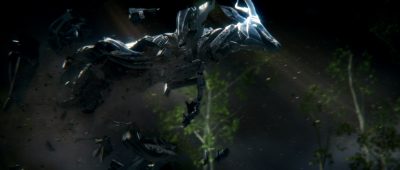 For one particular shot of a hoof impacting on the ground and causing grass and plant life to start growing, artists looked to the initial design frame by Park. “It was the initial design frame of this shot that inspired the whole story for her,” recalls Weil. “It is a nod to Hayao Miyazaki’s amazing animated film Princess Mononoke, the idea of life and growth spawning and growing from the creatures and the car parts. Based on her design frame, we matched the composition and began creating various plants to grow from the ground. We modeled and rigged all of the plants as opposed to using PaintFX.”
For one particular shot of a hoof impacting on the ground and causing grass and plant life to start growing, artists looked to the initial design frame by Park. “It was the initial design frame of this shot that inspired the whole story for her,” recalls Weil. “It is a nod to Hayao Miyazaki’s amazing animated film Princess Mononoke, the idea of life and growth spawning and growing from the creatures and the car parts. Based on her design frame, we matched the composition and began creating various plants to grow from the ground. We modeled and rigged all of the plants as opposed to using PaintFX.”
Charlex’s toolkit ranged from Maya to mental ray, Houdini, RealFlow and Cinema 4D, with Smoke and Flame for the editing and 2D finishing, and After Effects used during the previs stage for comping and editing. As an internal project, Weil says things went very smoothly, and artists were certainly encouraged when Gabriel Byrne came on board to narrate the piece.
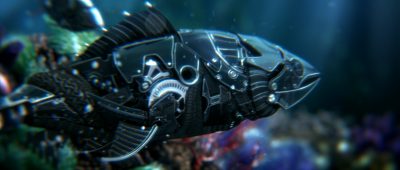 “It was a thrill to have Gabriel Byrne do the voice acting,” says Weil. “Adding talent of this caliber to this work really helped give it shape. Fitzgerald’s deeply evocative words helped us to convey the idea of the dream, while Gabriel read the part as though he himself was in a dream state, giving the piece an entirely new life. It was a great experience and a wonderful example of the collaborative and additive nature of the creative process in filmmaking.”
“It was a thrill to have Gabriel Byrne do the voice acting,” says Weil. “Adding talent of this caliber to this work really helped give it shape. Fitzgerald’s deeply evocative words helped us to convey the idea of the dream, while Gabriel read the part as though he himself was in a dream state, giving the piece an entirely new life. It was a great experience and a wonderful example of the collaborative and additive nature of the creative process in filmmaking.”
Credit List
Director: Alex Weil
Narrated by: Gabriel Byrne
Co-Director and Designer: Diana Park
3D Lead/Lead Animator: Adam Burke
Lead Animator/Animation Development: John Karian
Lead Compositing Artist: Jesse Newman
Executive Producer: Chris Byrnes
Producer: Reece Ewing
CG Supervisor: Keith McCabe, Myung Lee
Lead Lighter: Salar Saleh
Lead Character Technical Director: Steve Mann
Lead Modeler: Alex Cheparev
Lighting/Texturing: Mike Marsek, James Fisher, John Cook, Frank Grecco, Cesar Kuriyama, Keith McMenamy, Anthony Patti, Tom Cushwa, Jina Lee, Jeff Chavez
Matte Painting: Jina Lee
Modeling: Hung Kit Ma, Han-Chin Lee, Anthony Patti
Animation: John Wilson, Sam Crees, Jay Randall, Carlos Sandoval
Rigging: Andre Stuppert, Charles Le Guen, Andrei Savu
FX: Greg Ecker, Johnathan Nixon, Mitch Deoudes, Santosh Gunaseelan
Editors: John Zawisha, Kevin Matuszewski
Compositing: Blake Huber
Director of Engineering: Robert Muzer
Chief Engineer: Jerry Stephano
Pipeline: Michael Stella, Dan Schneider
Coordinating Producer for the Director: Jen Cadic
Additional Editor: Eli Mavros
Music Composition: Stimmung; Peter Lauridsen
Sound Design: Stimmung; Andres Velasquez
EP of Audio: Stimmung; Ceinwyn Clark
Mix: Headroom; Fernando Ascani
Associate Producer: Michael Kaufman
Color Correct: CO3; Stefan Sonnenfeld

Fantastic !